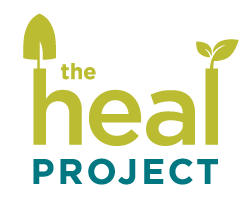Lasagna Garden Beds
By Fiona Benjamin
Since becoming the San Mateo County School Farm (SMCSF) manager, my focus has been on building the soil fertility at our little educational farm site. I believe that cultivating good soil fertility will not only allow us to grow more food to support our programming and share with the local Coastside community, but also to increase biodiversity and even help capture and safely store the atmospheric carbon that contributes to climate change.
That being said, building soil is no easy task. You may have heard that it takes over 100 years to build just one inch of topsoil. Ecological and human time do not necessarily operate on the same scale! However, any gardener knows that we don’t necessarily need to rely on natural processes to build fertility in our gardens; tools like compost and mulch can help feed our soil and build fertility in a much shorter time horizon.
Our soil food web mural at the farm: the soil food web is a complex web of interactions in which soil organisms and plants work together to each other's mutual benefit.
This is what I am working to do at the SMCSF. My goal is to build our soil organic matter (SOM) percentage up towards 5% from our current estimated 1-2%. To increase SOM, it is helpful to have an understanding of the soil food web. The soil food web is a complex group of interactions between plants, microbes, fungi and other invertebrates. In this web, plants feed sugars fixed though photosynthesis to soil organisms. In return, the soil organisms help the plant by forging for nutrients in the soil. Unfortunately, common agricultural practices are detrimental to these interactions, which threatens the foundation of a healthy soil. For example, fertilizing plants with synthetic nitrogen allows plants to sidestep the soil food web. Spraying pesticides causes damage not only to insect pests, but also to beneficial soil microbes. Perhaps the worst agricultural practice in terms of soil health is tillage, or mechanical manipulation of the soil. Tillage creates a temporary boost in fertility as soil organic matter gets ground up, oxidized, and digested by bacteria, but over time the practice reduces soil organic matter and destroys beneficial soil critters like fungi and earthworms. Moving away from these practices can be challenging, but it is also very important if you want to build great soil!
The first lasagna bed going in at the farm back in August.
One strategy I have been utilizing to reduce tillage and build fertility at the farm is the creation of “lasagna garden beds.” This term refers to a growing area that is created by the layering of organic materials. Though lasagna garden beds can have many different layers, I have found success with a relatively simple model. My beds contain a light base layer of compost, a layer of overlapping clean, plastic-free cardboard, then 1-2 inches of compost on top. With crops directly seeded into the compost on top, the result is almost zero weeds and a fluffy, rich soil layer underneath. In less than three months, the cardboard in our oldest lasagna bed has already decomposed! I have definitely noted increased earthworm populations in these beds—the carbon rich cardboard is a favorite food source of these super soil-building organisms! Building lasagna beds at scale requires a LOT of materials, and I have found our local community to be a huge asset. I am very grateful to Lyngso Garden Supplies for their generous donation of 32 yards of compost, Wheeler Farms for 12 yards of generously discounted compost, and to New Leaf Community Market and Markegard Family Grassfed for saving cardboard for us!
This glorious earthworm was under the first cardboard corner I lifted on one of our lasagna beds! Earthworms come to the surface to eat the cardboard, then pull the carbon rich material back into the soil. In the process they create tunnels for water and air infiltration and channels for plant roots to use, all while adding fertilizer!
Building a lasagna bed is one of the easiest ways to start a new garden plot at home. I recommend starting a few months before you want to start growing; fall is a great time to build a bed that will be ready to plant in the spring. Check out the links below for information on soil health and how to build your own lasagna bed. Remember, they don’t necessarily need to be very complicated or have many types of materials (mine only had cardboard and compost). Happy growing!
__
Fiona has been with The HEAL Project since 2018, first as a Farm Educator and now as the Farm Manager. As a native of the Coastside, she is grateful to have the opportunity to share her passion for healthy eating and the environment with her local community.



